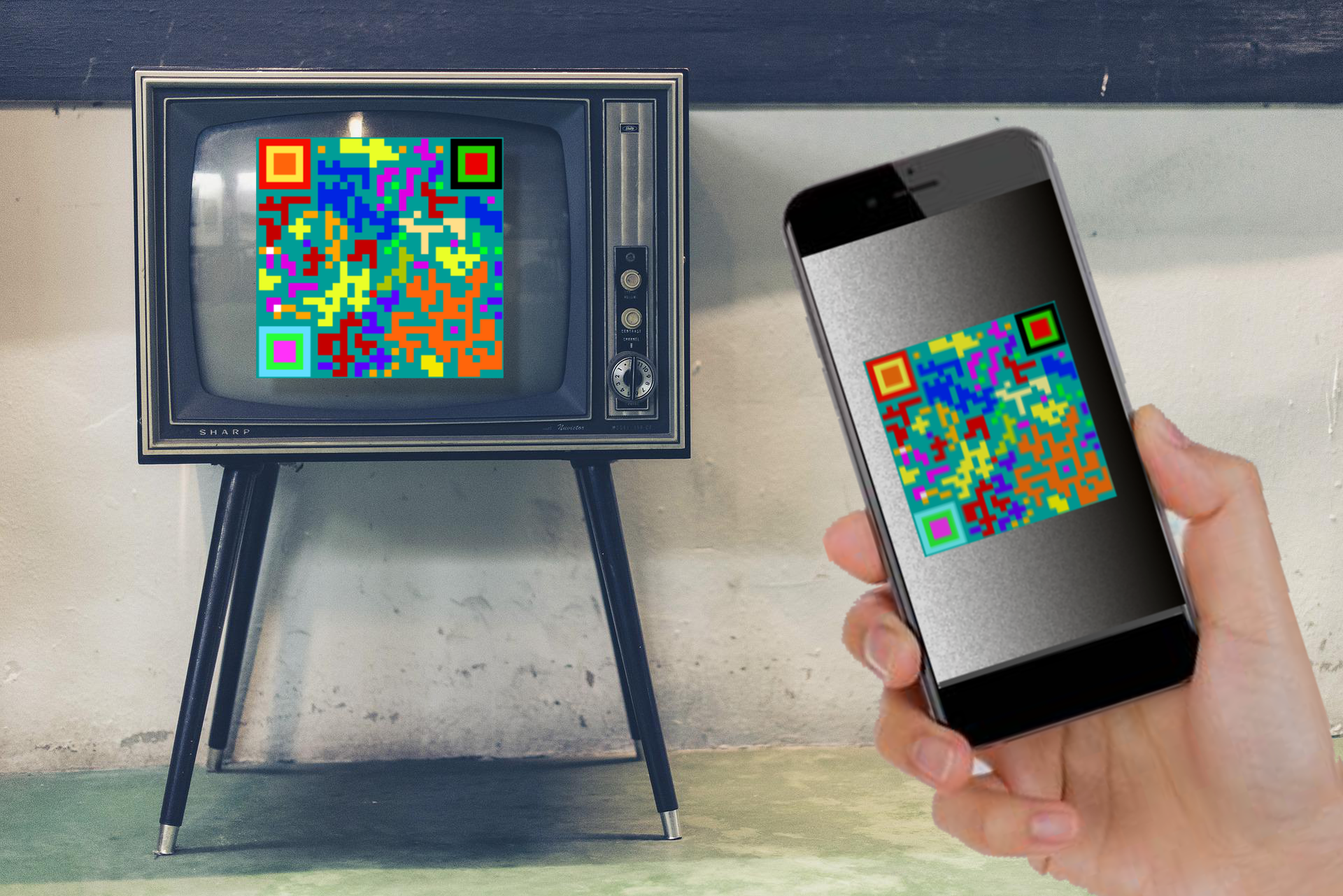QR Codes: The Remedy for Real-Time TV Advertiser Engagement, Attribution and Instant TV Data

You must've seen or heard about QR codes; a small graphic box with a "black and white" pattern that you can scan to quickly receive information. For example, you may have been to a restaurant to scan for a menu; or when you traveled your phone presented a QR code for boarding; or, if you scanned a QR code on a direct mailer you were able get additional information or contact the sender.
Ever since smart phone manufacturers added QR code scanning capabilities to their cameras a few years ago, the use of QR codes for marketing and advertising noticeably increased.
Still today QR codes are a nascent marketing tool. However, for TV advertisers it’s exactly what the doctor ordered and can solve the proverbial “holy grail” -- a real-time television engagement and attribution solution.
Why are QR codes beneficial for advertisers in general?
- A user can easily scan a QR code with their smartphone device without the need for opening 3rd party apps, typing phone numbers or typing URL’s.
- QR codes direct users to specific actions eliminating excess layers of response.
- QR codes are unique, and each can be placed on individual media properties to know where an engagement originated from.
- QR codes can allow scale and can be used on nationally basis or simply used on a hyper-local basis.
- There is no need for complicated integrations or set-up with QR codes.
Can linear TV and connected TV advertisers benefit from QR codes?
Absolutely.
Since Web 1.0 in 1995, TV advertisers have yearned for the same trackable metrics as web-based digital media platforms.
Previously, the print industry, radio industry, and OHH industry have all grudgingly adjusted to the digital era. Only recently have we’ve seen the emergence of streaming and connected TV platforms which are now grinding away at linear TV viewership and its ad dollars.
However, linear TV continues to encompass a large portion of TV ad budgets. But unlike traditional digital media, linear TV still needs a scalable solution for real-time engagement and attribution. And, although connected TV and streaming platforms allow TV advertisers to efficiently improve targeting, it too lacks a scalable engagement and attribution solution.
Fortunately for TV advertisers the use of QR codes does not depend on complex linear TV and connected TV infrastructures such as separate cable or OTT boxes, separate TV remotes, multiple backend systems and server technologies, and complicated integrations and creative executions.
The simplicity behind QR code technology solves the linear TV and connected TV engagement and attribution conundrum. It’s technology that can vastly improve real-time viewer engagement and allow real-time optimization of TV campaign performance.
Can QR codes improve TV response and optimize TV campaigns?
Yes.
TV advertisers currently use several traditional practices to engage audiences which include toll free numbers, URL’s and or text messaging. These tactics require the viewer to remember and manually dial phone numbers, type URL’s and text messages. These approaches provide multiple steps resulting in higher bailout and low response rates. And, in terms of reporting, TV advertisers often wait weeks or months to receive data to analyze their media buy.
With QR codes placed on a TV commercial the viewer effortlessly uses their phone’s camera to scan to engage. Once scanned, the viewer is immediately directed to any number of selected marketer actions including specific web pages, purchase pages, click-to-call, or even download product information all without typing or dialing. The entire process reduces bailout and improves response rates. Further, unlike traditional reporting, TV advertisers using QR codes can get immediate TV response data which can be quickly utilized to further optimize campaigns without waiting weeks or months for reporting data.
What should a QR code TV campaign solution include?
Current QR code resources offer many advantages for television advertisers but are limited. Consequently, emerging QR code TV advertisers may be missing out on additional data to help optimize their TV campaigns.
Most QR code solutions are supplied by SaaS (Software as a Service) providers. These providers offer basic services such as single marketer actions with minimal engagement reporting data. SaaS providers may also throttle the number of scans preventing scalable usage. Further, many providers redirect links through their own servers and may not be GDPR and TCPA compliant when it comes to certain data.
Implementing a successful QR code TV campaign requires more than a basic solution. Deploying a QR code TV ad campaign in real-time needs an efficient process with the ability to provide data beyond basic scan data.
An ideal QR code TV solution should provide a streamlined platform that includes a quick turnaround for TV creative production; product, offer and action set-up; dynamic QR code execution; and real-time reporting with instant data. Also, a solution should not limit scan capacity while at the same time be able to decipher engagement duplication and fraud. Additionally, the process should operate under strict GDPR and TCPA privacy guidelines.
Below is a glimpse of the tools and solutions TV advertisers should consider when deploying a real-time QR code TV advertising campaign with instant data.
- TV Creative Overlay Execution - A streamlined QR code process should include TV overlay creative with fast turnaround to eliminate an extra agency step for TV advertisers. TV creative capabilities should include J-Shape, lower thirds, and bugs, and the ability to modify QR code designs themselves for greater impact. Additionally, the creative process should have a TV commercial duplication capability to quickly merge unique QR codes for multiple media placements. It’s also important design around the creative constraints of the original TV commercial.
- Call to Action - If you are going to use QR codes you need a call to action either graphically or verbally. For example, “Scan Now”, “Scan for More Info”, “Scan to Text”. Since QR codes are new for TV, viewers may need direction on how to use them, plus adding CTA’s can further increase response rates.
- Dynamic QR codes - If you are executing a QR code TV campaign for multiple media properties it’s important your solution dynamically creates QR codes in bulk with unique identification for each QR code. This way each commercial can be uniquely identified.
- Modifiable Product and Offer Information with Action Flexibility – In addition to dynamic QR code creation, the solution should have an ability to dynamically connect products, offers and actions to specific QR codes and commercials. Further, the solution should have the ability to modify a product, offer or an action on the backend without the need to a replace the TV Commercial that’s been aired.
- Multiple Attributable Actions - Most QR code service providers offer one QR code for each action. An optimal solution would allow one QR code for multiple actions. The system should also be able provide inputs for unique links, unique phone numbers and other unique action related requirements, and should be able to accommodate a 1x1 pixel tag for each attributable action to close the consumer “loop”.
- Date, Timestamping & Time Zone - Every engagement and action should record the date, timestamp (down to the seconds), with the time zone. This will allow TV advertisers to optimize their engagement and attribution campaign based on dayparts including days and hours.
- Audience Impression Data - A robust solution should include audience impression data by media property, spot date and time code. Spot information combined with engagement data provides immediate response rates during the time-period the TV commercials ran.
- Instant Data Reporting - To fully optimize the QR code TV campaign, the solution should instantly report the entire customer funnel from the TV spot, through to initial engagement scan and then through to attribution. Having instant TV data is key to optimizing TV campaigns.
- GDPR & TCPA Compliancy - Stringent GDPR and TCPA privacy compliancy must be provided to include a viewer opt-in for use of GEO information including Longitude and Latitude, IP addresses, and time-zone information.
Conclusion
TV advertisers never had a real-time TV engagement and attribution solution in place. With the use of QR codes and the right solution Linear TV and Connected TV advertisers can now implement real-time engagement and attribution campaigns. TV advertisers can quickly execute campaigns on a mass scale without the hassle of legacy technology and costly set-up; and achieve greater ROI by optimizing TV campaigns in real-time. And finally, TV advertisers realize amazing benefits for their use including increasing response rates and customer acquisition.
Click the social buttons to share this story with colleagues and friends.
The opinions expressed here are the author's views and do not necessarily represent the views of MediaVillage.com/MyersBizNet.


